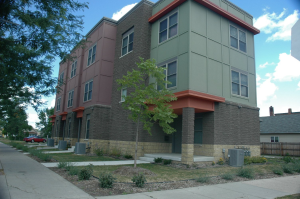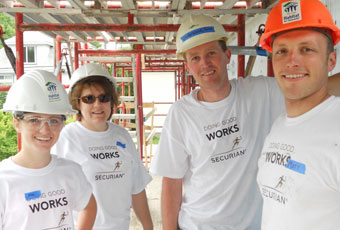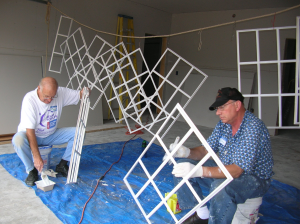Edgerton Street
East St. Paul is home to this new construction on Edgerton Street. There is a wide range of corporate and faith groups taking part in this ten week...


The Greater Frogtown Community Development Corporation (GFCDC) says on their website that “Lack of quality affordable housing is a pressing issue throughout the Twin Cities but it has become a major crisis in Frogtown. (Frogtown is an area located west of the Minnesota State capitol. It is a diverse neighborhood known informally as the "heart of St. Paul.") The neighborhood population has shot up because Frogtown’s low housing costs draw a large number of immigrant and low-income families. Health and safety conditions of housing stock are a growing concern.”
GFCDC is working to provide better housing options for the people in the Frogtown neighborhood. One project was to construct 16 rowhouse-style townhomes on Dale Street. Twin Cities Habitat for Humanity (TCHFH) built 5 units for this project. A 3-story 5-plex with a flat roof, tuck-under garages and outdoor living spaces, was completed by TCHFH in the spring of 2007. TCHFH used a cement-fiber siding and brick on the exterior of the complex instead of vinyl siding. This requires less maintenance and is more environmentally friendly.
Dale Street was widened several years ago, and GFCDC got the rights to the empty space. TCHFH then bought the land for the 5-plex from the community group.
TCHFH will be building an additional 4-plex and a 3-plex at the site in the near future.
Timeline:
July 2006: Groundbreaking
July 2007: Completion
July 2007: Dedications
Quick Facts:
Type of Housing: Multi-unit housing, 5-plex
Location: Frogtown (Dale Street, St. Paul, MN)
Families Served: 5
Architect: Glendenning (St. Paul, MN)
Construction Staff:
Field Supervisor: Rhonda Thorson
Site Supervisor: Rhonda Thorson
Special Builds:
The 2008 CEO Build and the 2008 RNC (Republican National Convention) Build were held in St. Paul at Dale Street sites.
Site History:
The Frogtown neighborhood began to emerge in the 1860’s. It was a popular area that attracted railroad workers as well as German, Polish, Irish and other groups of immigrants. In the mid 1900’s, Frogtown became a thriving African American community. The neighborhood was home to a busy streetcar route that ran through the city.
But with the increased popularity of the automobile, and construction of major freeways, the area lost many longtime residents and many storefronts became vacant.
During the past decade, local community groups, like the Greater Frogtown Community Development Corporation, have created several projects, hoping to revitalize the neighborhood once again.
Fun Facts:
Sponsors & Partners:
Cornerstone Sponsor:
Raise the Roof Golf Tournament
Community Sponsors:
AmeriCorps
SHOP (Self-help Homeownership Opportunity Program)
St. Paul PED (St. Paul Planning and Economic Development)
For more information about the organizations, click on the sponsor name.
Your gift unlocks bright futures! Donate now to create, preserve, and promote affordable homeownership in the Twin Cities.

East St. Paul is home to this new construction on Edgerton Street. There is a wide range of corporate and faith groups taking part in this ten week...

Twin Cities Habitat for Humanity (TCHFH) broke ground on their first home of a 24-home project in 2006. The project's goal was to complete 8 houses...

As Week 5 begins on Edmund Avenue, the Holy Hammers are starting to hang drywall and painting the outside of the home a country blue. In front of...